body language reading公开课
- 格式:ppt
- 大小:4.08 MB
- 文档页数:22








Unit 4 Body Language 教案2(SHOWING OUR FEELINGS<PART 2>) IntroductionThis period aims at training the students’ reading skill. The students have to get the general idea of how body language expresses our feelings. Having read the two articles, the students are expected to sum up the functions and similarities of body language. What’s more, the students are encouraged to express their feelings with body language.Teaching Important PointsDevelop the students’ reading skill to get all the needed inform ation.Train the students’ abilities to express their opinions of why body language is important. Teaching Difficult PointsHow to tell that the same body language shows different feelings in different cultures. Teaching MethodsReading skill directing.Task-based activity.Teaching AidsA tape-recorder, a projector, some slides and a multi-media computer.Three Dimensional Teaching AimsKnowledge and SkillsTrain the students’ abilities to know more body language.Enable the students to sum up the functions of body language.Train the students’ abilities to express their opinions on why body language is important. Process and StrategiesGet the students to learn about the functions and similarities of body language.Necessary explanation to help them get the main idea of the passage.Feelings and ValueBody language is an important non-verbal communication. Learning about the meanings ofsome body language in different cultures and applying it properly is of great help to our daily communication.Teaching ProceduresStep 1 lead inThe teacher describes some situations and the students are required to act them out.T: What gestures do we usually do in the following situations?1. I’m hungry.2. I’m full.T: You know a lot about gestures. Then can you figure out the meanings of the following gestures in the following pictures?What’s the matter?OK.Step 2 Pre-readingBefore reading the text, assign some questions for the students to discuss. So they may read the text later with their own questions in mind.T: I would like you to discuss the following questions with your group members. After 4 minutes, one from each group will present your discussion.Questions:1. What is the function of body language?2. What do you think the role of body languages is in our daily life?3. Is all the body language the same in the world? What do you know about them?After 4 minutes, ask some students to present their discussion.T: Now, who would like to express your idea? V olunteer!S: 1. I think the major function of the body language is to show all kinds of ideas, feelings, wishesor attitudes.T: Great! How about the second question?S: 2. Body language is as important as spoken language in our daily life.T: Good. I think sometimes, it’s even more important than spoken language. When you don’tunderstand a foreign language, body language can help you to communicate with the foreigners.How about the last question?S: 3. I don’t think all the body languages are the same in the world. The same body language canexpress different feelings or ideas in different cultures. For example, nodding the head means“yes” in many countries but in some Asian countries it means “no”.T: Well done! So we could summarize that communication is very important in our life,sometimes learning to get along well with others is more important than getting some more knowledge. So we should learn more body language, try our best to get along well with the peoplearound us.Step 3 First readingT: Let’s read a passage about how to show our feelings with body language. Read the passage anddecide which of these statements are true and which are false. Tick the correct box. If thestatement is false, explain why it is wrong.1. Body language is never as important as spoken language.2. If you are angry at a person, you might turn your back to him or her.3. You can threaten a person by refusing to speak.4. If you stand with your arms across your body, you are always protecting yourself from being physically attacked.5. If you sit looking away from a person, or with your back turned, you are saying you are not interested in that person.6. You should not greet your new boss by giving her or him a hug.7. Body language is the same all over the world.8. Most people can understand each other if they try.Step 4 Second reading (Group work)T: You are going to read the passage again and try to find some of the body language which showsimilar feelings or ideas and some which show different feelings or ideas in different cultures.1. frowning or turning one’s back tosomeoneto show anger2. closing one’s hand and shaking it atsomeoneto threaten that person3. nodding the head up and down to show agreement4. shaking the head to show disagreement or refusal5. looking away from a person oryawningto show no interest to the person6. standing, holding your arms acrossyour chestto protect yourself from an unwanted conversation 7. sitting, looking at and turning towardsthe person you are talking toto show you are interested8. rolling your eyes and turn your head away to show you do not believe what you hear or you do not like it1. children’s looking directly at an adultin Asia and South Americanot good behavior2. children’s not looking directly at the teacher in North America to get punishment from their teachers because they think the children are not telling the truth.1. a smile 1. A smile usually intends to put people at ease.2. A smile does not always mean that one is happy.3. A smile can hide other feelings, such as anger, fear or worry.4. If someone “loses face” they may smile to hide it.2. a hug to your boss or teacher probably not a good idea to show respect3. standing too close to your boss orteachernot acceptableStep 5 Further ReadingT: Just now we have learnt that body language has different meanings in different cultures. Now let’s learn more and get details of different body language. Before reading the text, first have alook at the exercises. The information was found in the notes left by an anthropologist. You need to arrange it so that it can be used in a report on international greetings. Organize the information so that it can be used to write a summary. I will give you 5 minutes to finish the task.After 5 minutes, the teacher asks some students to give their own answers.S: 1. It can be dangerous for you to meet people you do not know.S: 2. Many Asian people do not usually physically touch strangers.S: 3. If we show an open hand, it means that we are not holding anything dangerous.S: 4. The right hand is usually used because it is almost always the stronger.S: 5. People shake their hands when meeting people to show that they can be trusted.S: 6. To show respect Muslim people will touch their heart and mouth when greeting someone. Step 6 Post-reading discussionAfter reading the two passages, the students have a general knowledge on bod y language. It’s time for them to go fu rther to discuss the open questions and to express their opinions. The students are encouraged to discuss in groups so that they can communicate with their members and hear others’ opinions.1. How can we know other’s feelings, even if they do not speak to us?2. Why should we be careful of our own body language?3. Why is it important to watch others as well as listen to them?Step 7 Talking practiceSample descriptionsVarious answers are possible.1 Policemen catching a criminal:Three men ran towards the man who was carrying the bag. One of the three men pointed something at the man and moved his left arm up and down. The man with the bag dropped the bag and put his hands in front of him, palms forward. His mouth was open and he closed his eyes. The man who had been pointing at him reached out and grabbed one of the man's arms. He turned the man around and held both of the man's arms behind his back. Then he took out something from his pocket and put it on the man's wrists. Two of the three men put their hands on the man's shoulder and led the man away. The man hung his head.2 A person getting a taxi: A man was standing on the sidewalk. He was looking very carefully at the cars on the street. When a red car with a light on its roof came, he stepped forward,stretched out his right arm and waved it up and down. He kept his hand open, the palm of his hand facing down. The car stopped, he opened the door, sat down, put on his seat belt and the car drove off.3 Tai chi: This morning, I saw a group of people standing in a park. One of them stood in front the others and the rest were all watching him. He lifted one of his feet off the ground and moved his arms in a big circle. All the others did the same. Then the man lifted his foot higher and bent his knee. He put his left arm over his head and stretched out the other one. The others followed. Additional actions:Two people hugging each other: Two people saw each other on the street. They both stopped, made a strange noise, and then ran towards each other. They put their arms out and it looked like they were going to fight each other. When they got close, they put their arms around each other and jumped up and down.A person tying his or her shoes: I saw a girl walking. She stopped and bent down. She put her hand on each side of her foot and lifted two strings. Then she moved her hands in circles and crossed her arms. When she was finished, she stood up and walked away.Step 9 HomeworkT: Today, we have learnt so much about body language. Homework for today is to summarize what you have leant about body language and translate the five sentences on page 64.。


